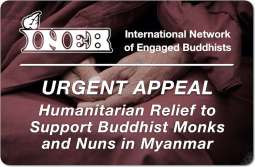大毘盧遮那成佛神變加持經 The Mahāvairocanābhisaṃbodhi-vikurvitādhiṣṭhāna-vaipulyasūtra-indrarājanāmadharmaparyāya, in Tibetan rNam par snang mdzad chen po mngon par rdzogs par byang chub pa rnam par sprul ba byin gyis rlob pa shin tu rgyas pa mdo sd'i dbang po rgyal po zhes bya ba'i chos gyi rnam grangs, and in English, Manifest Enlightenment of the Grand Resplendent One, His Transformations and Empowering Presence: Lord Indra of the Broader Sūtras; commonly abbreviated as 大日經. T.848.18.1-55, 7 fasc., translated by Subhākarasiṃha 善無畏 with the assistance of Yixing 一行 in 724; commonly abbreviated as Vairocanābhisaṃbodhi 大日經. The primary theme of this work, which is of utmost importance in East Asian esotericism, is the realization of the mind seeking enlightenment 菩提心. This theme is addressed in the opening dialogue between Mahāvairocana 大日如来 and an assembly led by Vajrapāṇi 執金剛秘密主, who inquires about omniscient knowledge (sarvajñājñāna 一切智智). The Bhagavan responds that "it is caused by the mind which seeks enlightenment, is founded on sympathy for others, and culminates in skilful methods" (karuṇāmūlaṃ bodhicittahetukam upāyaparyavasānam 悲爲根本。菩提心爲因。方便爲究竟). Enlightenment is defined as "knowing one's mind for what it really is" 謂如實知自心, and subsequent chapters are devoted to describing the skilful methods 方便 for its accomplishment. Foremost among these methods is entrance into the maṇḍala born from great compassion (mahākaruṇāgarbhodbhava-maṇḍala 大悲胎蔵生曼荼羅), described at length in chapter two, The Relevant Equipment 具縁品.' Later chapters deal with the entire gamut of esoteric techniques: the practice of mantras 真言, the fire ceremony (homa 護摩), the wheel of syllables (akṣāracakra 字輪), meditation on the stūpa of five cakras 五輪塔, and so on. However, unlike many previous esoteric works, in this text such techniques are almost exclusively oriented towards the accomplishment (siddhi 成就) of enlightenment rather than worldly goals. Many early sources for these esoteric practices have been established: for example, the three-family (kula 部) system can be found in the Dhāraṇīsamuccaya 陀羅尼集經, and its maṇḍala is indebted to the Vajrapāṇyabhiṣeka-tantra 金剛手潅頂續 (To.496). It is likely that the original text was composed in the mid-seventh century CE, when esotericism gained the status of legitimate "hot topic" among Buddhist monastics in India. Whīe a Sanskrit version has never been found, fragments have been located in diverse sources: the Kriyāsaṃgraha (To.2531), the Indonesian Sang Hyang Kamahāyānan Mantranaya, the Bhāvanākrama, and the Pradīpoddyotana.
The Chinese text is based on a manuscript recovered from the belongings of the pilgrim Wuxing 無行 (d.674), which, as with many tantras, is said to have been a condensed version (laghutantra 略本) abridged from a lengthy original (mūlatantra 廣本) of 100,000 verses 迦陀.
An ambitious attempt at reconstructing the Sanskrit was made by Jiun 慈雲 (1718-1804), who made use of citations in the principal Chinese commentary, the Darijingshu 大日経疏 [T.1796]. This exhaustive and accessible commentary, along with a well-maintained ritual tradition, have contributed greatly to the text's continuing importance in the Japanese esoteric schools. By contrast, it seems to have attracted little attention in Tibet, where it was translated no later than the early ninth century by Śīlendrabodhi and dPal-brtegs. Lucid and generous commentaries by the eighth-century pandit Buddhaguhya 佛密 (Sangs-rgyas-gsang-ba), such as the Vairocana-abhisambodhitantrapiṇḍartha (To.2662, P.3486), were also translated into Tibetan. For scholastics such as mKhas-grub-rje 智法祖師 (1385-1438) the text's most noteworthy feature is its advocacy of a yoga without semiosis (animittayoga 無相三昧, mtshan ma med pa'i rnal byor), a practice which qualifies its preeminent rank among the cārya 行 tantras in the Tibetan classification. The sequence of chapters in the Chinese and Tibetan editions differs slightly, suggesting that in later times chapters were reordered in accordance with exegetical tradition. Correspondences between chapter numbers are as follows: 1-5:1-5, 6+7:6, 8-12:10-14, 13:16, 14:15, 15-26:17-28, 27+31:29, 28-30:7-9. The seventh fascicle of the Chinese version is a ritualisation of the entire text, apparently composed later than the preceding chapters and circulated as a separate work in India. This short ritual text, the Mahāvairocana-abhisaṃbodhisambaddhapūjāvidhi, was also translated by Vajrabodhi 金剛智 as the Abridged Recitation Sūtra 要略念誦經 [T.849].
(經名)大日經之具題。經文六卷,供養次第一卷,共七卷,唐善無畏譯。真言三部經之一。胎藏界密部之本經也。【參見: 大日經】。謂大日如來自成佛以不思議之加持力說內證法之經典也。離神力之加持。不能說。不能聽。就此真言一宗有自證說法,加持說法之大論,遂分古義新義之兩派。【參見: 法身】。玆將本經各家之著述列之如下。大毘盧遮那成佛經疏二十卷(唐一行記),大毘盧遮那成佛神變加持經義釋十四卷(唐一行述記),大毘慮遮那成佛神變加持經義釋演密鈔十卷(遼覺苑撰),大毘盧遮那經供養次第法疏二卷(唐不可思議撰)。













